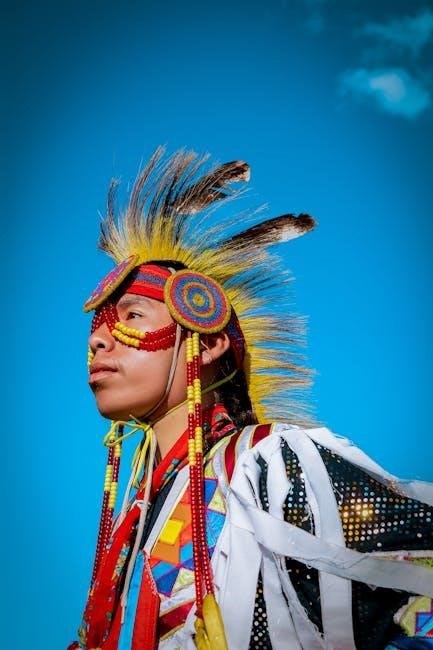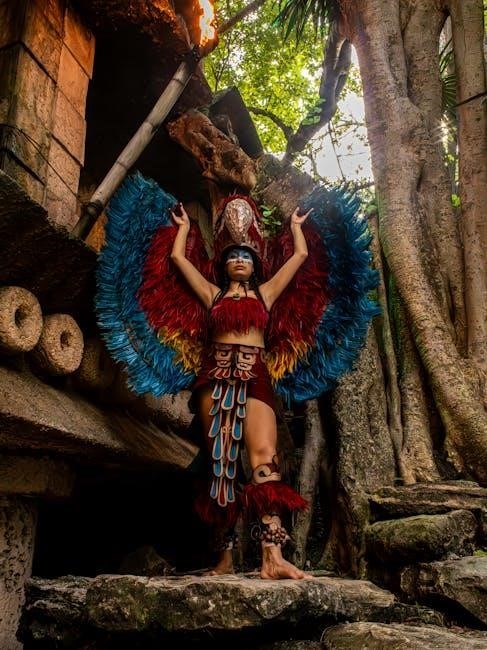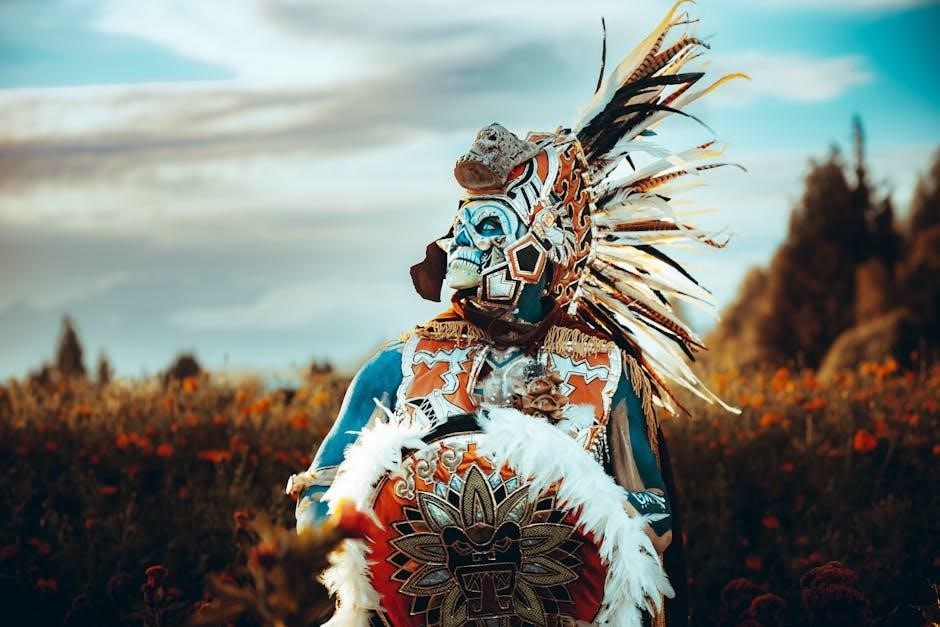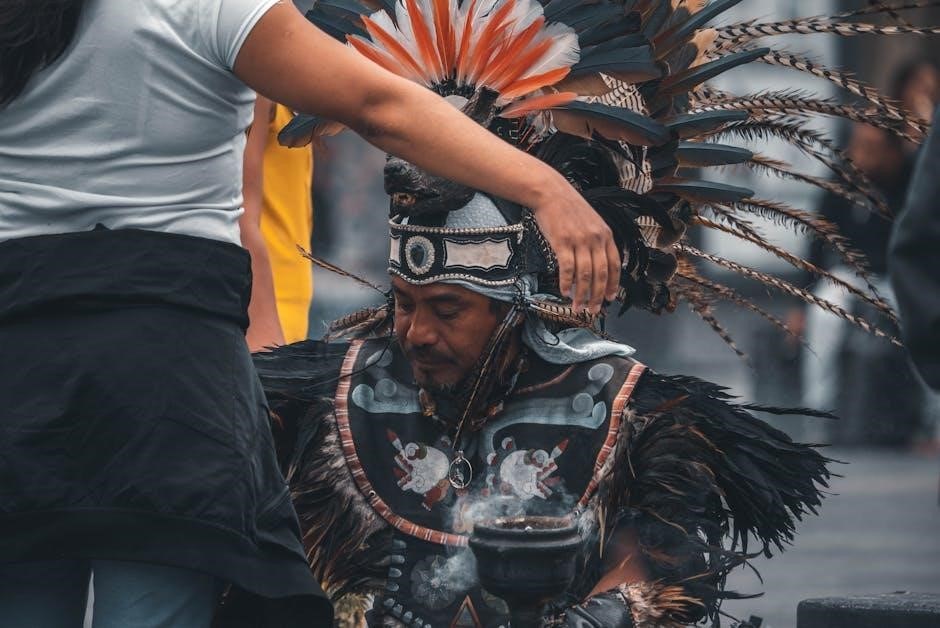Native American symbols are deeply rooted in cultural heritage, spirituality, and tradition. These meaningful designs convey stories, beliefs, and values, often used in art, rituals, and daily life. Discover their significance in our Native American Symbols and Meanings PDF, perfect for educational purposes and cultural appreciation.
Overview of the Importance of Symbols in Native American Culture
Native American symbols hold profound significance, serving as a bridge between the spiritual, cultural, and natural worlds. They are integral to traditions, beliefs, and communication, often representing values, stories, and ancestral wisdom. Symbols appear in art, rituals, and daily life, embodying the tribe’s identity and connection to their environment. These meaningful designs preserve cultural heritage and foster a sense of unity, while also educating future generations about the rich history and traditions of Native American communities.
The Role of Symbols in Communication and Expression
Native American symbols were vital tools for communication, enabling tribes to share stories, beliefs, and cultural values. These pictographs and designs conveyed complex ideas and emotions, often used in rituals, art, and daily interactions. Symbols expressed spirituality, traditions, and history, serving as a universal language across diverse tribes. They allowed individuals to connect, preserve their heritage, and pass down wisdom to future generations, fostering understanding and unity within and between communities.

Historical Background of Native American Symbols
Native American symbols trace their origins to ancient times, used by indigenous tribes to represent cultural and spiritual beliefs. They were integral to rituals, art, and storytelling, preserving heritage and bridging the physical and spiritual realms for generations.
The Origins of Native American Symbolism
Native American symbolism traces its roots to ancient indigenous tribes, whose cultures revolved around nature and spirituality. Symbols were used in storytelling, rituals, and art to convey beliefs and values. These designs often depicted animals, natural elements, and celestial bodies, each carrying specific meanings. They served as a bridge between the physical and spiritual worlds, preserving history and cultural identity. The origins of these symbols are deeply tied to the tribes’ connections with their environments and their spiritual practices, making them integral to their way of life and heritage.
The Evolution of Symbols Across Different Tribes
Native American symbols evolved uniquely across tribes, reflecting regional cultures, beliefs, and environments. While some symbols, like the arrow and bear, were widely recognized, their meanings varied. Plains tribes emphasized bison and hunting imagery, while Southwestern tribes often depicted coyotes and desert elements. These variations highlight the adaptability of Native American symbolism, shaped by geographical and cultural differences. Over time, symbols incorporated new influences yet retained their spiritual and storytelling essence, preserving each tribe’s distinct identity and traditions.
The Role of Symbols in Preserving Cultural Heritage
Symbols play a vital role in preserving Native American cultural heritage by transmitting traditions, beliefs, and histories across generations. Through art, rituals, and storytelling, these symbols maintain communal identity and spiritual connections. They serve as a bridge between the past and present, ensuring that cultural values endure despite external influences. By documenting symbols in resources like the Native American Symbols and Meanings PDF, their significance remains accessible, fostering education and appreciation for indigenous traditions and heritage.
Common Native American Symbols and Their Meanings
Native American cultures use a variety of symbols to represent spiritual, cultural, and natural elements. These symbols, such as the Medicine Wheel, Feather, and Thunderbird, carry deep meanings tied to heritage and tradition, often documented in resources like the Native American Symbols and Meanings PDF for educational purposes.
The Thunderbird: A Symbol of Power and Protection
The Thunderbird is a legendary creature in Native American cultures, often depicted as a powerful bird of immense size. It is associated with thunderstorms, strength, and divine protection. Many tribes reverence the Thunderbird as a symbol of power and creation. In art and stories, it is frequently shown with outstretched wings, embodying control over natural forces. The Thunderbird is also a guardian, warding off evil spirits and harm. Its significance varies across tribes, but its role as a protector and a link to the divine remains consistent, as detailed in the Native American Symbols and Meanings PDF.
The Feather: Representing Honor, Courage, and Spirituality
The feather holds profound significance in Native American cultures, symbolizing honor, courage, and spirituality. Often used in ceremonies and adornments, feathers represent strength and wisdom. Eagle feathers are particularly revered, associated with prayers and communication with the divine. They are also awarded to warriors for bravery. The feather’s lightness and ability to soar symbolize spiritual ascension and connection to the heavens. Native American Symbols and Meanings PDF explores its role in rituals and its enduring importance across tribes, highlighting its cultural and spiritual value.

The Medicine Wheel: A Symbol of Balance and Harmony
The Medicine Wheel is a sacred symbol representing balance, harmony, and the interconnectedness of life. Consisting of a circle divided into four sections, it embodies the four directions, elements, seasons, and stages of life. Each quadrant often corresponds to specific colors and teachings, guiding individuals toward spiritual and physical well-being. Used in rituals and healing practices, the Medicine Wheel reflects Native American wisdom about living in harmony with nature and oneself. Native American Symbols and Meanings PDF delves into its cultural significance and timeless teachings.
The Arrow: Signifying Protection, Courage, and Strength
The arrow is a powerful Native American symbol, representing protection, courage, and strength. Often depicted in art and jewelry, it signifies resilience and the ability to overcome challenges. In ceremonies, arrows are used to ward off negative energies and bring divine protection. A single arrow embodies individual strength, while a bundle of arrows symbolizes unity and collective power. Native American Symbols and Meanings PDF explores its cultural significance, highlighting its role as a guide for spiritual and physical protection, ensuring harmony and balance in life.
The Bear: Embodying Leadership and Healing
The bear is a revered Native American symbol, embodying leadership, healing, and strength. It represents protection and wisdom, often associated with tribal leaders and healers. Bears are seen as protectors, guiding communities in times of need. In many tribes, the bear is linked to medicine and spiritual renewal, symbolizing the power to heal and transform. Its strength and resilience inspire courage and determination. Native American Symbols and Meanings PDF highlights the bear’s significance, showcasing its role in rituals and art as a powerful emblem of cultural and spiritual values.
The Butterfly: A Messenger of Transformation and Hope
The butterfly holds profound significance in Native American cultures, symbolizing transformation, renewal, and hope. Its life cycle, from caterpillar to winged beauty, mirrors spiritual growth and change. Many tribes view the butterfly as a messenger between the physical and spiritual worlds, carrying prayers and stories. It represents the beauty of life’s journey and the promise of new beginnings. Native American Symbols and Meanings PDF explores the butterfly’s role in rituals, stories, and art, highlighting its enduring symbolic importance in indigenous traditions and beliefs.

Spiritual and Religious Symbolism in Native American Culture
Spiritual symbolism is central to Native American culture, reflecting deep connections to nature, ancestors, and the divine. Symbols like the Medicine Wheel and smudging rituals embody spiritual practices, fostering harmony and balance in life. Native American Symbols and Meanings PDF reveals how these sacred elements guide spiritual journeys and honor the Creator, ensuring traditions thrive across generations.
The Medicine Wheel: A Sacred Symbol of Life and Balance
The Medicine Wheel, a revered Native American symbol, embodies the circle of life and balance. It represents the interconnectedness of physical, mental, emotional, and spiritual realms. Native American Symbols and Meanings PDF highlights its significance as a tool for ceremonies and teachings. The four directions—east, south, west, and north—symbolize seasons, colors, and elements. The center often represents the Creator or Sun, signifying life’s sacredness. This ancient symbol guides individuals toward harmony within themselves and with nature, reflecting the holistic worldview of Native American cultures.
Smudging: A Ritual for Purification and Spiritual Cleansing
Smudging is a sacred Native American ritual for purification and spiritual cleansing. It involves burning sacred plants like sage, sweetgrass, or cedar to release their purifying properties; Native American Symbols and Meanings PDF explains how smudging cleanses spaces, objects, and people of negative energies. The smoke is believed to carry prayers to the spirits, promoting healing and protection. This ancient practice is deeply rooted in spiritual traditions and continues to be a vital part of ceremonies, ensuring balance and harmony in daily life and cultural celebrations.
The Sun and Moon: Symbols of Life, Death, and Rebirth
The sun and moon are powerful symbols in Native American culture, representing the cycles of life, death, and rebirth. The sun embodies warmth, light, and vitality, often associated with masculine energy and the creation of life; The moon, with its phases, symbolizes feminine energy, intuition, and the spiritual realm. Together, they represent balance and the eternal cycle of existence. These celestial bodies are frequently depicted in art and rituals, highlighting their profound significance in spiritual and cultural practices.

Nature-Inspired Symbols and Their Meanings
Nature-inspired symbols are central to Native American culture, representing spiritual and cultural significance. Animals, natural elements, and plants convey deep meanings, connecting people to the environment and its rhythms.
Animals as Symbols: The Deer, Eagle, and Wolf
In Native American culture, animals like the deer, eagle, and wolf hold profound symbolic meanings. The deer represents gentleness, grace, and abundance, while the eagle symbolizes strength, vision, and spiritual connection. The wolf embodies loyalty, perseverance, and wisdom. These animals are often depicted in art and stories, teaching moral lessons and cultural values. Their roles vary across tribes, but they universally inspire admiration and respect, reflecting humanity’s deep bond with nature and its creatures.
Natural Elements: Water, Fire, and Wind
Natural elements like water, fire, and wind hold deep symbolic meanings in Native American cultures. Water, often represented by a cupped hand, symbolizes life, healing, and purity. Fire embodies transformation, strength, and spiritual renewal, while wind represents breath, change, and the whispers of ancestors. These elements are frequently depicted in art and rituals, reflecting their vital role in sustaining life and connecting humanity to nature. Their significance varies across tribes but universally emphasizes harmony with the environment and the divine.
Plants and Trees: The Significance of the Cedar and Sage
Plants like cedar and sage hold profound cultural and spiritual significance in Native American traditions. Cedar is often used in rituals for purification and protection, symbolizing strength and longevity. Sage, known for its cleansing properties, is burned in smudging ceremonies to purify spaces and minds. Both plants are deeply rooted in tribal customs, representing health, protection, and spiritual growth. Their use in ceremonies and daily life highlights their importance in maintaining balance and harmony within communities and the natural world.

Ceremonial Symbols and Their Significance
Ceremonial symbols, such as the Sacred Pipe and Drum, hold deep spiritual meaning in Native American rituals. They represent peace, prayer, and healing, connecting communities to their heritage and the divine.
The Sacred Pipe: A Symbol of Peace and Prayer
The Sacred Pipe, or Chanunpa, is a revered symbol in many Native American cultures. Used in ceremonies, it represents spiritual connection, peace, and prayer. Smoking the pipe signifies unity and offerings to the Creator. Each part of the pipe holds meaning: the bowl symbolizes Mother Earth, while the stem represents the connection between heaven and earth; It is a powerful tool for meditation, healing, and resolving conflicts, embodying the spiritual heart of Native American traditions.
The Drum: A Tool for Healing and Ceremonial Rituals
The drum holds profound significance in Native American culture, serving as a vital instrument in ceremonies and healing rituals. Its rhythmic beats connect communities, honor ancestors, and channel spiritual energy. Often made from animal hides and wooden frames, the drum symbolizes heartbeat and life. Used in dances, prayers, and storytelling, it unites people and fosters harmony. The drum’s resonance is believed to carry prayers to the spirit world, making it an essential tool for healing, celebration, and cultural preservation.
The Rattle: Used in Healing and Spiritual Ceremonies
The rattle is a revered instrument in Native American culture, primarily used in healing rituals and spiritual ceremonies. Made from materials like gourds, seeds, or beads, its rhythmic sound is believed to purify, heal, and connect with the spirit world. Shamans and healers often shake rattles during rituals to ward off negative energies, restore balance, and invoke divine guidance. The rattle’s significance extends beyond sound, symbolizing prayer, renewal, and the harmony between physical and spiritual realms.

Regional Variations in Native American Symbols
Native American symbols vary across regions, reflecting local culture, geography, and heritage. Each tribe’s unique environment influences its artistic expression and symbolic representations, showcasing rich cultural diversity.
Plains Indian Symbols: The Bison and Teepee
The bison and teepee are iconic symbols of Plains Indian culture, reflecting their deep connection to the land and traditions. The bison, a vital resource, represents strength, survival, and abundance, while the teepee embodies home and community. These symbols, often depicted in art and stories, highlight the Plains Indians’ nomadic lifestyle and harmony with nature. They serve as powerful reminders of their rich heritage and the importance of preserving cultural identity for future generations.
Southwestern Symbols: The Coyote and Cactus
The coyote and cactus are prominent symbols in Southwestern Native American cultures, representing resilience and adaptability. The coyote, often depicted in stories, embodies cleverness and survival, while the cactus, particularly the saguaro, symbolizes life and endurance in arid landscapes. These symbols reflect the region’s harsh yet vibrant environment and the resourcefulness of its indigenous peoples. They are frequently featured in art and folklore, serving as reminders of the Southwestern tribes’ deep connection to their land and heritage.
Northwestern Symbols: The Salmon and Totem Pole
In Northwestern Native American cultures, the salmon and totem pole hold profound significance. The salmon represents abundance, renewal, and the cycles of life, often celebrated in rituals and storytelling. Totem poles, carved with intricate designs, symbolize tribal identity, ancestry, and spiritual beliefs. Each figure on the pole embodies a story or ancestor, serving as a visual narrative of the community’s history and values. These symbols are integral to the cultural and spiritual fabric of Northwestern tribes, reflecting their deep connection to nature and heritage.

Native American Symbols in Modern Context
Native American symbols are now widely used in art, jewelry, and literature, preserving cultural identity and inspiring contemporary creativity. Their meanings continue to resonate deeply today.
The Use of Symbols in Native American Art and Jewelry
Native American symbols are widely incorporated into art and jewelry, preserving cultural heritage and conveying deep spiritual meanings. Arrows symbolize protection, while bears represent courage and leadership. Butterflies embody transformation and hope, often depicted in intricate designs. These symbols, such as water, fire, and wind, are used in pottery and jewelry to tell stories and connect with ancestral traditions. Their meanings are now shared through educational resources like the Native American Symbols and Meanings PDF, making them accessible for cultural appreciation and learning.
The Role of Symbols in Preserving Cultural Identity
Native American symbols play a crucial role in preserving cultural identity by serving as a bridge between past and present. They embody the history, traditions, and spiritual beliefs of indigenous communities. Through art, jewelry, and storytelling, these symbols connect people to their heritage, fostering unity and pride. Educational resources like the Native American Symbols and Meanings PDF help share these traditions, ensuring their legacy endures for future generations. Symbols not only preserve cultural identity but also inspire a deeper appreciation for Native American wisdom and resilience.
Symbolism in Modern Native American Literature and Film

Modern Native American literature and film often incorporate traditional symbols to convey cultural values and spiritual beliefs. These symbols, such as the Thunderbird or Feather, resonate deeply, connecting audiences to ancestral wisdom. Authors and filmmakers use them to explore identity, resilience, and the intersection of tradition and modernity. The Native American Symbols and Meanings PDF serves as a valuable resource, helping creators and audiences alike understand the richness behind these motifs. This cultural storytelling bridges generations, preserving heritage while inspiring new narratives.
Native American symbols hold profound cultural and spiritual significance, preserving traditions and beliefs. The Native American Symbols and Meanings PDF offers a valuable resource for education and appreciation, ensuring these meaningful designs endure for future generations to learn from and cherish.
Final Thoughts on the Significance of Native American Symbols
Native American symbols are profound expressions of cultural identity, spirituality, and tradition. They encapsulate the history and values of indigenous communities, serving as bridges to the past. Native American Symbols and Meanings PDF resources offer insights into these designs, revealing their deeper significance. From the arrow symbolizing protection to the butterfly representing transformation, these icons embody timeless wisdom. Their enduring relevance underscores the importance of preserving cultural heritage for future generations to learn from and appreciate.

